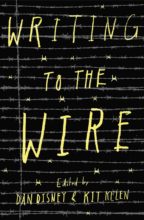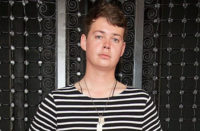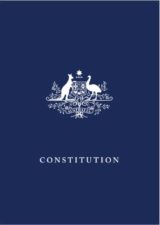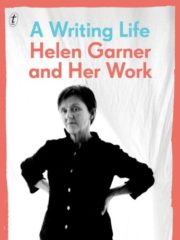 Writing to the Wire
Writing to the Wire
Edited by Dan Disney and Kit Kelen
UWA Press
ISBN 9781742588667
Reviewed by ALICE ALLAN
To live on the Australian continent is to be aware of the people who are excluded from it—those who are currently incarcerated in places coolly dubbed ‘detention centres’. Writing to the Wire, edited by Dan Disney and Kit Kelen, presents the work of poets grappling with this reality alongside that of poets actually living it.
An anthology such as this can be successful in a number of ways. At the very least, it can record a perspective beyond what Disney and Kelen describe as the ‘shameless procedural narratives’ that ‘damage our collective ethics and our nation’s sense of identity’. The recording of this perspective alone makes Writing to the Wire a necessary document. Even if Australia’s detention centres are shut down tomorrow, their repercussions will be felt for generations. In the aftermath, we will need to know how our poets responded.
We can also evaluate Writing to the Wire in terms of its position as an activist anthology. The editors admit that the collection is perhaps ‘a little like bashing your head against a brick wall’ or ‘like speaking to a wall’, but we do not have to link these poems to concrete political change to consider them valuable. Each poem is itself an act against what Kelen and Disney call ‘mute complicity’, registering ‘shock, disbelief, disgust, dismay, despair, contempt, cold fury’—never acceptance.
Another question we can ask of a collection like this is to what degree it amplifies the voices of those behind ‘the wire’. One of the most striking aspects of this anthology is the strong contrast between poems by those seeking asylum in Australia and poems by Australian citizens. Consider, to begin with, ‘My soul died years ago’ by poet NH, who was seeking asylum at the time of publication:
There are butterflies in my stomach.
I am very very very cold.
I have been dead for years
but my body is screaming.
It hits itself to the ground
and shouts: ‘I am tired of compulsory life’.
Reading these lines, the ‘mute complicity’ inherent in a comfortable Australian life is starkly obvious. While there are just 18 poems by people who have gone through the process of seeking asylum included in the 204-page collection, their resonance is such that the impact of many of the surrounding poems becomes muted. This is particularly apparent when it comes to poems written by Australians that examine an asylum seeker perspective. In ‘Illegals’, for example, Mark Tredinnick encircles all experiences of exile by writing of an ‘us’ that comes ‘just as far, across the hungry infernal sea’:
But the new land when we step down
onto its abstemious beaches
is so much more like a prison than home,
Another jail to break, another hope to abandon
Like memory in the sea.
Later we learn the language
of freedom, all its civil syllables,
But our tongues, parched from cruising so shabbily and so long into exile,
Will never learn to say our own names again
While there is no question of poetic quality here, there is a distance between the two writers’ experiences. Tredinnick is not alone in writing from the perspective of those seeking asylum—a number of poets have taken this approach to create their contributions. Again, these poems are the result of skilful, considered writing, but their inclusion also highlights the fact that those writing from outside the wire can only ever reach toward understanding, while those inside, in poet Ravi’s words, ‘have come into your very deep water / and have now sunk / in that deepest suffering’.
In making their selections, Disney and Kelen could have taken the same approach as the editors of the more recent anthology They Cannot Take the Sky, which is limited to writing by people who have experienced mandatory detention. The wealth of work by those who have no direct experience of detention in Writing to the Wire creates a broader conversation—a space where Australian poets can examine, in the editors’ words, ‘the idea of being Australian’.
While this is clearly a worthwhile task, the cumulative effect of the many poems by Australian writers somehow fails to amplify their impact. In fact, there’s often a sense of interference, especially when poems that are extremely strong cover the same or similar ground as those that are less accomplished. There’s an obvious irony in arguing for a more stringent selection process here—Kelen and Disney explicitly state that they were ‘guided by principles of inclusivity, pluricentricity and multivalence’—but perhaps fewer poems may have resulted in stronger collection overall.
All that said, Writing to the Wire also includes many poems by contributors who recognise where their understanding falls short and reveal this gap in thoughtful ways. In ‘Nationality II’, Melinda Smith uses found text from the Australian Human Rights Commission’s The Forgotten Children report to bring voices other than her own onto the page:
I feel like a killer
when they use my boat number.
The flat dead eyes of the mother. The gouges
on her son’s forearms.
Boat number has become like our first name.
The glut of bread that sticks in the craw.
This juxtaposition of Smith’s own words against those from the report addresses the question of whether her subject has been seen or merely spoken for. Other poets are more direct in marking their position as outsiders. Peter Minter’s ‘A Letter to You’ begins ‘I can’t think of anything. / I have nothing to say.’ Heather Taylor Johnson’s ‘In the Bottom Eight’ asks ‘What else to do but clear the table and bring out the next course? Bleu cheese goes best with a third bottle of wine, not racism.’ Brook Emery’s ‘Return to Sender’ ends with that bleakly familiar phrase ‘you can bloody well go back where you belong.’
Disney and Kelen explicitly state in their introduction ‘We do not speak for the people incarcerated by Australian governments: they are speaking for themselves here’. While this may not be true of every single poem in the collection, it is clear that the editors are aware of their responsibility to elevate the voices of ‘people who would like to be Australians’. The fact that this problem of ‘speaking for’ is on editorial agendas, in writers’ minds and obvious to readers is exhilarating. It suggests historically silenced voices are becoming more audible.
Representing the experiences of asylum seekers, either directly or from a remove, is not the only focus of this anthology. Many of the poems here also bring to light what Kelen and Disney call ‘a collective burden of shame’. In ‘Queue-jumping’ Anthony Lynch catalogues positions of privileged safety in a poem that reads like a judge’s sentence:
When the pact was signed
I was eighth in line for a decaf.
When the navy arrived
I poured myself a second Scotch.
When the boat was towed
I sent my tenth email of the day.
When security tightened
we bought the fourth-best house in the street.
Along with shame, the ‘cold fury’ Disney and Kelen describe is another key theme, most obvious in poems addressing Australia’s politicians. In ‘Reply to a father from a Federal Member’, Nathan Curnow writes in the voice of politician giving parenting advice after two young boys hear about a detention centre suicide:
Tell them we’re calmly implementing policies.
In fact try saying it was ‘a horrible, tragic death’,
keep repeating it like a sober example,
after all, we’re in the business of saving lives
and that phrase helps discourage the journey.
Each of the poems in this anthology reveals an Australia so many would prefer to ignore. Nevertheless, Kelen and Disney position Writing to the Wire as ‘a book of hope—a book to make us look and think and feel again’. The collection begins with a poem in which Kelen asks a simple question:
And: For those who’ve come across the seas
We’ve boundless plains to share. Remember?
By the final page, each contributor has done their part in this work of remembering, adding a new layer to a complex and confronting picture.
In the unlikely event that Writing to the Wire inspires no action at all, it will at least endure as a record of Australia’s policies towards those forced to seek asylum here. By collecting the words of those who continue to feel the full force of these policies alongside the bewilderment of those who are watching their effects unfold, it answers its own epigraphic question, posed by Julian Burnside in his Hamer Oration: ‘What have we become?’
ALICE ALLAN is a writer and editor living in Melbourne. Her work has been published in journals such as Rabbit, Cordite, Going Down Swinging and Offset.
 Robbie Coburn was born in Melbourne and grew up on his family’s farm in Woodstock, Victoria. His poems have been published in various journals and magazines including Poetry, Cordite, The Canberra Times, Overland and Going Down Swinging, and his poems have been anthologized. His first collection, ‘Rain Season’, was published in 2013 and a second collection titled The Other Flesh is forthcoming. He lives in Melbourne.www.robbiecoburn.com.au
Robbie Coburn was born in Melbourne and grew up on his family’s farm in Woodstock, Victoria. His poems have been published in various journals and magazines including Poetry, Cordite, The Canberra Times, Overland and Going Down Swinging, and his poems have been anthologized. His first collection, ‘Rain Season’, was published in 2013 and a second collection titled The Other Flesh is forthcoming. He lives in Melbourne.www.robbiecoburn.com.au Constitution
Constitution Hunger: A Memoir of (My) Body
Hunger: A Memoir of (My) Body Kate
Kate Adam Day is the author of the collection of poetry,
Adam Day is the author of the collection of poetry,  A Writing Life: Helen Garner and Her Work
A Writing Life: Helen Garner and Her Work  Lindsay Tuggle has been widely published in journals and anthologies, including: Cordite, Contrapasso, HEAT, Mascara, Rabbit, and The Hunter Anthology of Contemporary Australian Feminist Poetry(2016). She was short-listed for the University of Canberra Vice-Chancellor’s International Poetry Prize, judged by Simon Armitage. Her work has been recognised by major literary awards, including: the Gwen Harwood Poetry Prize (shortlisted 2015), the Val Vallis Award for Poetry (second prize 2009, third prize 2014), and the Canberra Vice-Chancellor’s Poetry Prize (shortlisted 2016, longlisted 2014). Her first collection, Calenture, is forthcoming with Cordite Publishing. The manuscript evolved from residential writing fellowships awarded by institutions including the Australian Academy of the Humanities, the Library of Congress, and the Mütter Museum of Philadelphia. Tuggle also writes on intersections of poetry and science. The University of Iowa Press’s Whitman Series invited her first book, The Afterlives of Specimens: Science and Mourning in Whitman’s America (forthcoming in 2017). She wrote a chapter on ‘Poetry and Medicine’ for Cambridge University Press’sWhitman in Context (2017). She teaches literary studies at Western Sydney University.
Lindsay Tuggle has been widely published in journals and anthologies, including: Cordite, Contrapasso, HEAT, Mascara, Rabbit, and The Hunter Anthology of Contemporary Australian Feminist Poetry(2016). She was short-listed for the University of Canberra Vice-Chancellor’s International Poetry Prize, judged by Simon Armitage. Her work has been recognised by major literary awards, including: the Gwen Harwood Poetry Prize (shortlisted 2015), the Val Vallis Award for Poetry (second prize 2009, third prize 2014), and the Canberra Vice-Chancellor’s Poetry Prize (shortlisted 2016, longlisted 2014). Her first collection, Calenture, is forthcoming with Cordite Publishing. The manuscript evolved from residential writing fellowships awarded by institutions including the Australian Academy of the Humanities, the Library of Congress, and the Mütter Museum of Philadelphia. Tuggle also writes on intersections of poetry and science. The University of Iowa Press’s Whitman Series invited her first book, The Afterlives of Specimens: Science and Mourning in Whitman’s America (forthcoming in 2017). She wrote a chapter on ‘Poetry and Medicine’ for Cambridge University Press’sWhitman in Context (2017). She teaches literary studies at Western Sydney University. Adolfo Aranjuez is editor of Metro, subeditor of Screen Education, and a freelance writer, speaker and dancer. He has edited for Voiceworks and Melbourne Books, and been published in Right Now, The Lifted Brow, The Manila Review, Eureka Street and Peril, among others. Adolfo is one of the Melbourne Writers Festival’s 30 Under 30. http://www.adolfoaranjuez.com
Adolfo Aranjuez is editor of Metro, subeditor of Screen Education, and a freelance writer, speaker and dancer. He has edited for Voiceworks and Melbourne Books, and been published in Right Now, The Lifted Brow, The Manila Review, Eureka Street and Peril, among others. Adolfo is one of the Melbourne Writers Festival’s 30 Under 30. http://www.adolfoaranjuez.com Writing to the Wire
Writing to the Wire